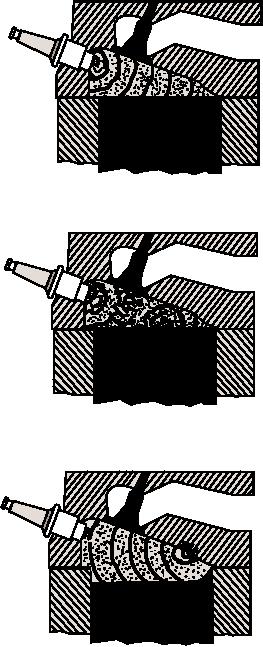
preignition the fuel-air mixture begins to burn before
result is a knock, a ping, or a detonation. In detonation,
the spark occurs. This condition may be caused by an
the spark from the spark plug starts the fuel mixture
overheated exhaust valve head, hot spark plugs, or
burning, and the flame spreads through the layers of the
glowing pieces of carbon within the combustion
mixture, very quickly compressing and heating them.
chamber. Figure 4-1 shows the diagramed course of the
The last layers become so compressed and heated that
fuel-air mixture in the cylinder under circumstances of
they explode violently. The explosive pressure strikes
preignition and detonation, as well as in normal
the piston head and the walls of the cylinder, and causes
combustion.
the knock you hear in the engine. It is the fuel, not the
engine that knocks. Besides being an annoying sound,
Q4-1. Gasoline's tendency to change from a liquid
persistent knocking results in engine overheating, loss
to a vapor is know by which of the following
of power, and increased fuel consumption. It causes
terms?
severe shock to the spark plugs, pistons, connecting
1.
Octane rating
rods, and crankshaft. To slow down this burning rate of
2.
Combustibility
the fuel, you must use a fuel of a higher octane rating.
3.
Volatility
4.
Detonation
OCTANE RATING
The property of a fuel to resist detonation is known
as its antiknock or octane rating. The octane rating is
obtained by comparing the antiknock qualities of
gasoline in a special test engine. In the test engine, the
compression can be raised or lowered, and other engine
controls are provided to make the engine knock or
detonate. Two separate fuel chambers are also
provided, with a rapid means of changing from the fuel
being tested to the standard reference fuel. This
reference fuel consists of a mixture of isooctane, which
NORMAL
has a very high antiknock rating, and heptane, which
produces a pronounced knock. The octane rating of a
gasoline being tested is the percentage by volume of
isooctane that must be mixed with normal heptane to
match the knocking of the gasoline being tested. Octane
numbers range from 50 to over 100. A number higher
than 100 indicates that the antiknock value is greater
than that of isooctane.
An engine that does not knock on a low-octane fuel
will not operate more efficiently by using a fuel of high
octane rating. An engine that knocks on a given fuel
D E TO N AT I O N
should use one of a higher rating. If a higher octane fuel
does not stop the knocking, some mechanical
adjustments are probably necessary. Retarding the
spark so that the engine will fire later may end
knocking. However, an engine operating on retarded
spark will use more fuel and will overheat. It may be
less expensive to use a higher priced, high-octane
gasoline with an advanced spark than to use a cheaper,
low-octane gasoline with a retarded spark.
Also, a spark that is too advanced, a lean fuel
mixture, a defective cooling system, or preignition may
be responsible for knocking. Preignition should not be
PREIGNITION
ASf04001
confused with engine knock itself, which occurs late in
Figure 4-1.--Combustion process.
the combustion process after the spark has occurred. In
4-2

